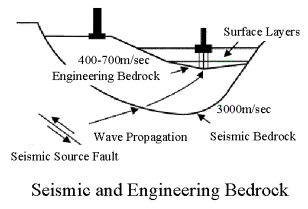
The seismic waves are generated due to the shear dislocation of the seismic source fault, suffer the influences of the materials through which they propagate and arrive at the ground surface (See figure below). In general, the earthquakes of the larger magnitude and of the shorter distance from the seismic source to observation site cause the stronger ground motion. Besides of the magnitude and the distance, the ground characteristics must be taken into account, because they have a firm relation with earthquake disaster due to the amplification of seismic waves in the soft deposit.
In order to bring the quantitative ground motion estimation into practical stage, it is convenient to divide these complex phenomenon in the following two parts. Suppose that there is a buried interface in that we can approximate the up-going waves vertical and laterally homogeneous in practically useful extent. Then, One of the divided two parts is the source effects with the influence of propagation path that gives the input wave to the interface. Another is the influence, i. e., amplification in the shallower sedimentary layers. The above mentioned interface is called "Seismic Bedrock" in general. The following two conditions are required for the interface, "Seismic Bedrock".
1) The interface has a practically useful lateral extent and the physical properties of the underlying stratum are not varied along this interface.
2) The strata deeper than this interface is much more homogeneous in comparison with the layers shallower than the interface.
As the shear wave velocity of upper earth crust is as homogeneous as from 3000 to 3500 m/sec, the upper interface of the upper earth crust having 3000 m/sec of the shear wave velocity is called "Seismic Bedrock".
In the viewpoint of Earthquake Engineering, it has been proposed, based on the followings, to use the shallower interface of which underlying stratum has from 300 to 700 m/sec of the shear wave velocity. This interface is called "Engineering Bedrock".
1) The most important problem for earthquake engineering is not whether the long period components are dominant in the ground or the short period components, but whether the pre-dominant period of the ground is close to the proper period of the structures constructed or planned on the mentioned ground. Therefore, "bedrock" can not be absolutely defined, but have to be defined in different ways even in the same site depending on the structure.
2) "Seismic Bedrock" of the cities in Japan is buried at the depth where very few strong motion records have been obtained. In contrast, there are much more strong motion records obtained at "Engineering Bedrock". Therefore, it is the practically useful way to consider "bedrock" at this depth.
3) Except of the plains around the Tokyo metropolitan area, Osaka City and Nagoya City, there is not any information about such deep structure as "Seismic Bedrock". Even these exceptional examples, the information available is not sufficient. Therefore, it is quite difficult to estimate amplification characteristics of the ground shallower than "Seismic Bedrock".
The both definitions of "bedrock" are widely used in the field of quantitative strong motion estimation. In the textbook of Earthquake Engineering, "Bedrock" and sometimes "Seismic Bedrock" is used in the context where "Engineering Bedrock" should be used. In contrast, the textbook of Seismology uses "Bedrock" where it should be called "Seismic Bedrock". It is important to distinguish the definition of the terms where they are used, by the context or the glossary.
